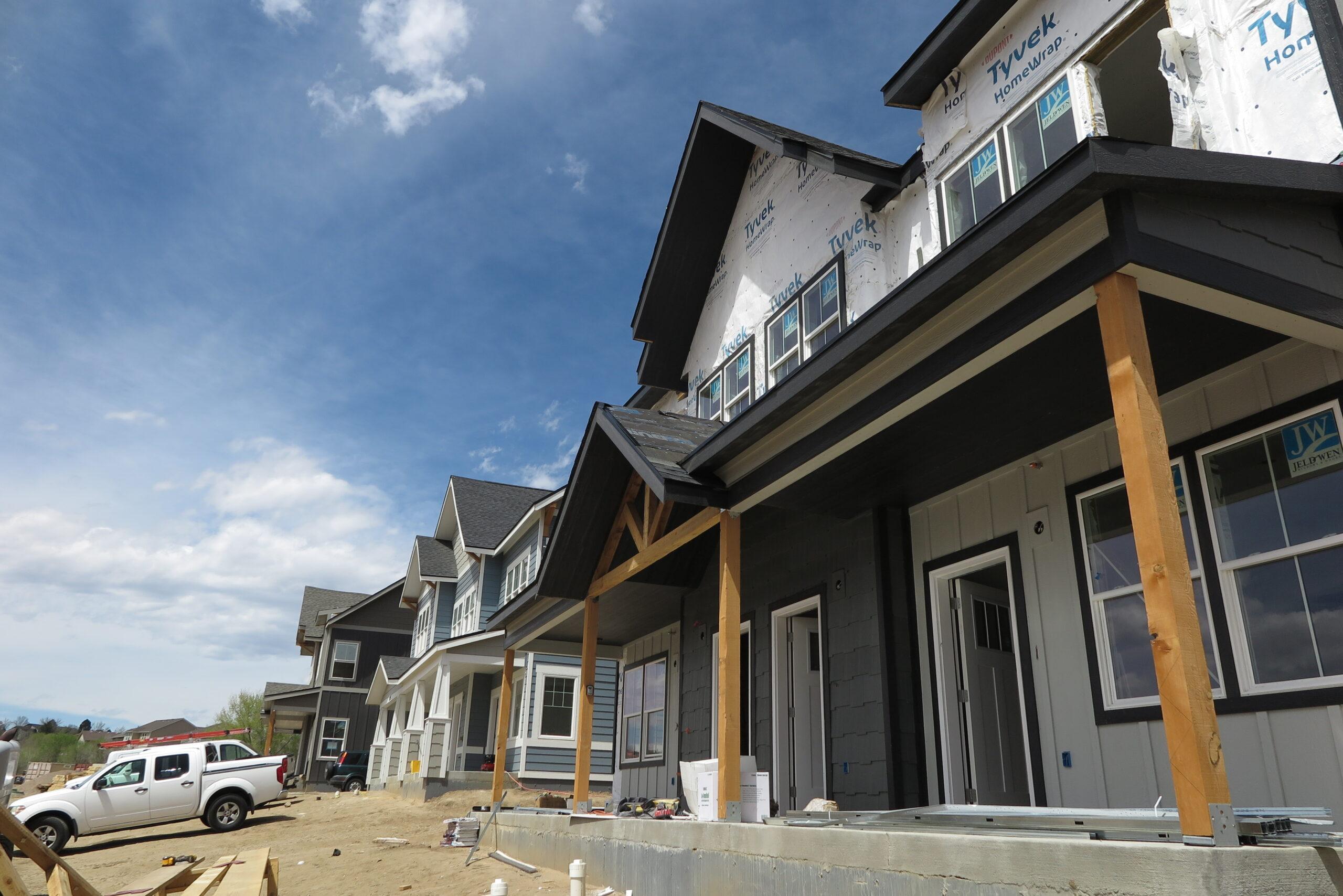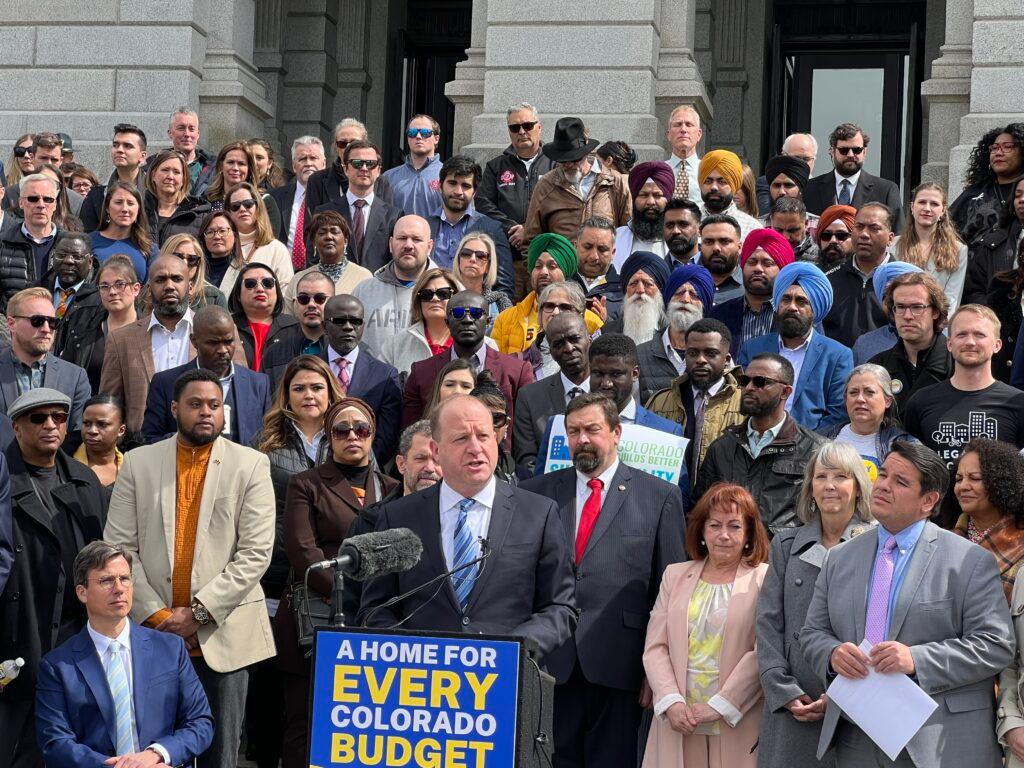
The Polis administration has laid out a sweeping plan that would explicitly allow more dense housing across Colorado’s increasingly expensive metropolitan areas and resort communities, even if residents and local elected officials object to it.
The “More Housing Now” proposal, revealed Wednesday, would be a significant shift in how Colorado’s cities and towns grow, and who has the ultimate power to shape that growth.
“We're at a real inflection point here where we need a smart plan, in an inter-jurisdictional way, for more housing, for rent and for purchase, close to where jobs are and along transit lines with opportunities for people to get where they want to go,” Colorado Gov. Jared Polis said in an interview.
Polis’ proposal has the backing of environmental groups, affordable housing advocates, labor leaders, business interests and some local government officials. But it’s sure to draw stiff opposition from other local leaders who believe their long-held power over land use planning is sacrosanct.
Big changes for big cities
The end of single-family-only zoning in the state’s largest cities, metro areas and mountain resort communities could happen under the bill, which will soon be introduced and is being sponsored by Sen. Dominick Moreno, D-Commerce City, Rep. Iman Jodeh, D-Aurora, and Rep. Steven Woodrow, D-Denver.
So-called “Tier 1” cities would see the biggest impact from the Polis proposal. They include the state’s largest, such as Denver, Colorado Springs, Aurora, Fort Collins, Lakewood, Greeley, Boulder, Grand Junction, Pueblo and Arvada, plus smaller cities within large metro areas, like Castle Rock, Edgewater, Louisville, Windsor and Fountain. (See below for a full list.)
Those communities would have to allow the construction of “middle housing,” defined as townhomes and multiplexes with up to six units, as well as accessory dwelling units, on lots in all residential neighborhoods. (New single-family homes would still be allowed, too.)
The bill would not require cities to actually build those denser options. But it would open the door for developers to propose and construct them much more easily.
Neighborhoods in attractive markets could see a surge of denser construction — and local elected officials and neighborhood groups would lose much of their power to stop it.
Cities could still customize their codes, for example by adding design requirements.
“People take pride in their neighborhoods and in their communities, and part of that is in fact how they look,” Jodeh said. “Those standards are there to make sure that people can still do that.”
Cities would not be allowed to require parking for any of the denser “middle” housing types. Rather, the amount of parking per unit would be left to developers to decide.
“Why would we be … forcing people to pay for parking who don't even have a vehicle themselves?” Polis said.

“Tier 1” cities also would have to allow and encourage denser development around rail stations, certain bus transit lines and commercial corridors. They could choose from policies like raising density limits and eliminating parking requirements.
The bill would not contain more funding to expand the state’s public transportation offerings, Polis said, though said he’s excited to “look at additional options we might have to support transit.”
“This bill is a different topic,” he said. “It's about housing and enabling more customers to exist for transit.”
The bill also requires more planning by state and local governments to allow growth where the market demands it, Polis said. Tier 1, smaller “Tier 2” cities and high country resort areas would have to create housing plans to detail how they plan to address housing shortfalls and keep current residents from being priced out, with goals identified by the state.
Those areas would have to choose from a “menu” of strategies. Polis administration officials haven’t detailed those options yet.
If a local government fails to meet the “minimum standards” of the bill, the state would override local zoning rules and implement a standardized code instead. That standardized code would be developed by the state’s Department of Local Affairs.
“Local governments have the incentive to be proactive on this and make sure that they're out in front, passing codes that meet the minimum standards but also make sense for their community,” Woodrow said.
The Polis proposal also would try to cut “red tape” by removing state-level regulations on housing, including:
- Streamlining rules around manufactured homes
- Removing minimum housing unit size restrictions in urban areas, except for fire and building code standards
- Remove limits in state law on the number of unrelated people who can live together
- Eliminate the power of homeowners’ associations to keep out certain types of housing.
Small cities and rural areas exempted
The bill is primarily focused on larger communities and resort areas. It will include various exemptions from the rules to reduce the impact on smaller cities and rural areas.
For example, mid-sized “Tier 2” municipalities would not face the requirement to allow triplexes and townhomes in all residential areas. They would, however, have to allow accessory dwelling units and be subject to the same removal of “red tape” regulations. Rural areas and the smallest cities would get even more exemptions.
This map lists communities by tier level, according to a document provided by Rep. Steven Woodrow:

This table shows which policies apply to each tier level, as described by Colorado Builds Better, a group involved in drafting the bill:
| Urban Municipalities Tier 1 | Urban Municipalities Tier 2 | Rural Resort Job Center Municipalities | Non-Urban Municipalities | Statewide (Counties, small munis) | |
| Housing Needs Assessments & Plans | X | X | X | ||
| Allow Accessory Dwelling Units | X | X | X | X | |
| Allow Middle Housing (Duplexes, triplexes, multiplexes, townhomes) | X | With additional flexibility | |||
| Encourage Transit Oriented Communities (rail) | X | ||||
| Encourage Development Along Key Corridors (bus transit, commercial corridors, etc.) | X | With additional flexibility | |||
| Removing Square Footage Requirements, Occupancy Restrictions | X | X | With additional flexibility | X | Occupancy restrictions only |
| Strategic Growth Planning & Water | X | X | X | X | Larger counties only |
Is it “The Colorado Way?”
Asked whether the bill amounts to the state taking land-use authority from local governments — a flashpoint in the debate over how to address Colorado’s housing shortage — Polis stressed the idea of “flexibility,” with cities getting multiple options to reach the overarching goal of increasing housing supply.
“Local governments need to step up and be part of the solution,” he said. “They can't just shift the burdens onto their neighboring jurisdictions and make themselves less affordable and put more traffic on the road, which we all wind up paying for in both air quality and lost productivity and time and traffic.”
Traditionally, local governments in Colorado have had the authority to make their own decisions about how to grow. For the last century or so, many of those decisions have resulted in suburban sprawl where commercial and residential zones are mostly kept separate.
And some highly desirable communities, like Polis’ own hometown of Boulder, have added far more jobs than housing. That’s all contributed to high housing costs, car dependency and long commutes, and the inefficient use of water and other resources, Polis said.
“We want to avoid becoming a place where the average home price is $1 million in our major metro areas, where people have to live 45 minutes, an hour out from where their jobs are,” Polis said. “We've seen areas of the country that have gone that way. I don't think that's the Colorado way.”
A recent paper in the journal Urban Studies examined hundreds of zoning reforms enacted across the U.S. It found that when governments loosen development restrictions, there is “a statistically significant 0.8% increase in housing supply within three to nine years of reform passage,” with most of the units falling at the “higher end” of rents.
Conversely, when governments restrict land uses, it results in higher rents and fewer affordable units, the study found.
Woodrow, a sponsor of the measure, said that the bill would boost the housing supply and people’s property rights.
“When you do get that house with the picket fence, do you wanna have the right to put a dwelling unit in your backyard? This bill says, ‘Yes, you have that right. And local governments cannot interfere with it,’” he said.
The proposal will face stiff resistance from some local leaders. The Colorado Municipal League has criticized the overall idea, saying that cities are in a better position to make decisions and the state should support them.
“We just got the bill last night, so we're still going through the details,” CML Executive Director Kevin Bommer said in an interview. “But … we know just from what has already been presented to us that it represents the most sweeping preemption of local land use and zoning authority that Colorado's probably ever seen. And certainly the biggest one in modern history.”
The Polis administration contends that it has spoken with scores of local leaders in developing the plan, and provided supportive statements from some of them.
“Housing is a crisis all over Colorado,” Glenwood Springs Mayor Jonathan Godes said in a statement. “Mountain communities have been leading on this issue for years, and we are happy that there is potential for statewide goals that align the entire state, while still respecting the differences in communities.”
| Urban Municipalities Tier 1 | Urban Municipalities Tier 2 | Rural Resort Job Centers | Non-Urban Municipalities |
| Denver region: Arvada, Aurora, Boulder, Brighton, Broomfield, Castle Pines, Castle Rock, Centennial, Cherry Hills Village, Columbine Valley, Commerce City, Denver, Edgewater, Englewood, Erie, Federal Heights, Glendale, Golden, Greenwood Village, Lafayette, Lakewood, Littleton, Lochbuie, Lone Tree, Longmont, Louisville, Northglenn, Parker, Sheridan, Superior, Thornton, Westminster, Wheat Ridge North Front Range: Greeley, Fort Collins, Loveland, Windsor Pikes Peak: Colorado Springs, Fountain Grand Valley: Grand Junction Pueblo Area: Pueblo | Denver region: Dacono, Fort Lupton, Firestone, Frederick North Front Range: Evans, Berthoud, Johnstown, Tinmath, Eaton, Miliken, Severance Pikes Peak: Monument | Aspen, Avon, Breckenridge, Crested Butte, Dillon, Durango, Frisco, Glenwood Springs, Mountain Village, Silverthorne, Snowmass Village, Steamboat Springs, Telluride, Vail, Winter Park | Alamosa, Brush, Canon City, Carbondale, Cortez, Craig, Delta, Eagle, Fruita, Fort Morgan, Gunnison, Gypsum, La Junta, Lamar, Montrose, Rifle, Sterling, Trinidad, Wellington |









